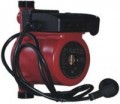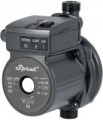Max. flow
The maximum flow of a pump is the amount of liquid it can pump in a certain amount of time.
Features of choosing the optimal performance option depend primarily on the purpose of the pump (see above). For example, for DHW recirculation models, the pump performance should not exceed the performance of the water heater. If the water heater is capable of delivering 10 litres per minute to the DHW circuit, then the maximum pump performance will be 10*60=600 L/h. The basic formula for calculating the performance of a heating system takes into account the power of the heater and the temperature difference at the inlet and outlet, and for the cold water system — the number of points of water intake. More detailed information about the calculations for each application can be found in special sources, and it is better to entrust the calculations themselves to professionals.
Max. head
The head can be described as the maximum height to which a pump can lift liquid through a vertical pipe without bending or branching. This parameter is directly related to the pressure that the pump produces: 10 m of head approximately corresponds to a pressure of 1 bar (do not confuse this parameter with operating pressure — see more about it below).
The head is one of the key specs for most circulation pumps. Traditionally, it is calculated based on the difference in height between the location of the pump and the highest point of the system; however, this principle is relevant only for units that
boost the pressure of cold water(see "Suitable for"). Circulation pumps for heating and DHW work with closed circuits, and the optimal pressure depends on the total hydraulic resistance of the system. Detailed calculation formulas for the first and second cases can be found in special sources.
Max. operating pressure
The highest pressure in the circuit at which the pump will be able to work normally.
Of course, this parameter cannot be exceeded — the unit may fail due to a breakdown caused by too high pressure (and even if this did not happen right away, it can happen at any time). However, it is worth choosing a model with some margin — so that the pump can normally withstand pressure surges, which are almost inevitable in any pipe.
Max. fluid temperature
The highest liquid temperature that the pump is capable of operating normally.
The possibility of using the unit directly depends on this parameter (see "Suitable for"): for example, models for heating systems must tolerate a temperature of at least 95 °C, and for DHW supply — at least 65 °C. Well, anyway, this parameter should not be exceeded: an overheated pump will fail very quickly, and the consequences of this can be very unpleasant.
Features
— Number of speeds. The number of speeds provided in the design of the pump. Each speed corresponds to its performance value (see above). The options could be:
- 1 speed. There are no adjustments in such models; when turned on, the pump can operate only at one speed. This is the simplest and most inexpensive option, due to the absence of additional elements (regulators) in the design. Of course, it is convenient only in cases where the unit must operate at full capacity every time it is turned on.
- 2 speeds. 2 speeds give the user some degree of choice: the pump does not have to be turned on at full power — when it is not required, the unit can be run at reduced power to save electricity and not wear out the mechanisms beyond what is necessary.
- 3 speeds. The largest number of adjustments found in modern pumps — it makes no sense to provide a larger number for many reasons. It gives even more options for setting operation parameters than 2 speeds.
- Stepless adjustment. This option implies the ability to set the regulator to any position from minimum to maximum (in some models, fixed settings may also be provided, but only as an additional option). It provides maximum freedom and precision in the choice of operating mode. However, it significantly affects the price; and the real need for smooth adjustment occurs quite rarely.
—
Automatic operating mode.... The essence of this function differs depending on the purpose of the device (see above). So, in models for increasing the pressure of cold water, the automation turns on the pump when the tap is opened and turns it off when it is closed — a special sensor reacts to the movement of water. In models for heating and domestic hot water, automation is responsible for adjusting the operating parameters — for example, when screwing the valves and reducing the flow rate, the pump can reduce the pressure, as well as, for additional functions, such as an on-off timer. Anyway, this feature makes life easier for the user, eliminating the need to perform certain operations manually and adding new features to the pump; but the specific set of these features depends on the model.
— Display. Various additional information can be displayed on the display: operating mode, performance settings, water temperature, set timers, error messages and much more. It makes management more convenient and intuitive. Pumps usually use the simplest form of black and white LCD screens, but this is quite sufficient for the purposes mentioned.
— Control panel. In this case, the control panel means a panel that has a switch with a choice of operating modes between automatic (see above) and manual. Accordingly, the presence of several modes almost necessarily means the presence of a control panel. But the speed switches themselves are not considered for this function.Max. power consumption
The electrical power consumed by the pump during normal operation and maximum performance.
This indicator directly depends on performance — after all, for pumping large volumes of water, an appropriate amount of energy is needed. And the power depends on two main parameters — electricity consumption and the load on the power grid, which determines the connection rules. For example, pumps with a power of more than 5 kW cannot be connected to ordinary household sockets; more detailed rules can be found in special sources.
Inlet
The size of the inlet provided in the design of the pump. For plumbing threads (see Connection), the size is traditionally indicated in inches and fractions of an inch (for example, 1" or 3/4"), for flanges, the nominal diameter (DN) of the bore in millimetres is used — for example, DN65.
This parameter must match the dimensions of the mount on the pipe to which the pump is planned to be connected — otherwise, you will have to use adapters, which is not very convenient, and sometimes not recommended at all.
Outlet
The size of the outlet provided in the design of the pump. The value of this parameter is completely similar to the size of the inlet (see above).
Country of brand origin
In this case, the country of origin refers to the country from which the product brand originates. A brand, in turn, is a general designation by which the products of a particular company are known in the market. The country of its origin does not always coincide with the actual place of production of the product: to reduce the cost of production, many modern companies transfer it to other countries. It is quite normal for products, for example, of an American or German brand, to be made in Taiwan or Turkey. Contrary to popular belief, this in itself does not lead to a decrease in the quality of the goods — it all depends on how carefully the brand owner controls the production. And many companies, especially large and famous ones, monitor the quality very zealously — after all, their reputation depends on it.

